Automated Theory Formation in Pure Mathematics: Distinguished Dissertations
Autor Simon Coltonen Limba Engleză Paperback – 27 sep 2012
| Toate formatele și edițiile | Preț | Express |
|---|---|---|
| Paperback (1) | 645.47 lei 6-8 săpt. | |
| SPRINGER LONDON – 27 sep 2012 | 645.47 lei 6-8 săpt. | |
| Hardback (1) | 651.51 lei 6-8 săpt. | |
| SPRINGER LONDON – 9 aug 2002 | 651.51 lei 6-8 săpt. |
Din seria Distinguished Dissertations
- 20%
 Preț: 290.51 lei
Preț: 290.51 lei - 15%
 Preț: 633.68 lei
Preț: 633.68 lei - 20%
 Preț: 654.05 lei
Preț: 654.05 lei - 20%
 Preț: 647.79 lei
Preț: 647.79 lei - 20%
 Preț: 994.92 lei
Preț: 994.92 lei - 20%
 Preț: 648.26 lei
Preț: 648.26 lei - 20%
 Preț: 328.60 lei
Preț: 328.60 lei - 20%
 Preț: 641.34 lei
Preț: 641.34 lei - 20%
 Preț: 328.09 lei
Preț: 328.09 lei - 20%
 Preț: 325.30 lei
Preț: 325.30 lei - 20%
 Preț: 926.94 lei
Preț: 926.94 lei - 20%
 Preț: 639.52 lei
Preț: 639.52 lei - 20%
 Preț: 640.69 lei
Preț: 640.69 lei - 20%
 Preț: 603.37 lei
Preț: 603.37 lei - 20%
 Preț: 637.56 lei
Preț: 637.56 lei - 20%
 Preț: 643.30 lei
Preț: 643.30 lei - 20%
 Preț: 640.51 lei
Preț: 640.51 lei - 20%
 Preț: 640.19 lei
Preț: 640.19 lei - 20%
 Preț: 325.63 lei
Preț: 325.63 lei
Preț: 645.47 lei
Preț vechi: 759.37 lei
-15% Nou
Puncte Express: 968
Preț estimativ în valută:
123.53€ • 128.49$ • 101.98£
123.53€ • 128.49$ • 101.98£
Carte tipărită la comandă
Livrare economică 15-29 aprilie
Preluare comenzi: 021 569.72.76
Specificații
ISBN-13: 9781447111139
ISBN-10: 1447111133
Pagini: 400
Ilustrații: XVI, 380 p.
Dimensiuni: 155 x 235 x 21 mm
Greutate: 0.56 kg
Ediția:Softcover reprint of the original 1st ed. 2002
Editura: SPRINGER LONDON
Colecția Springer
Seria Distinguished Dissertations
Locul publicării:London, United Kingdom
ISBN-10: 1447111133
Pagini: 400
Ilustrații: XVI, 380 p.
Dimensiuni: 155 x 235 x 21 mm
Greutate: 0.56 kg
Ediția:Softcover reprint of the original 1st ed. 2002
Editura: SPRINGER LONDON
Colecția Springer
Seria Distinguished Dissertations
Locul publicării:London, United Kingdom
Public țintă
ResearchCuprins
1. Introduction.- 1.1 Motivation.- 1.2 Aims of the Project.- 1.3 Contributions.- 1.4 Organisation of the Book.- 1.5 Summary.- 2. Literature Survey.- 2.1 Some Philosophical Issues.- 2.2 Mathematical Theory Formation Programs.- 2.3 The BACON Programs.- 2.4 Concept Invention.- 2.5 Conjecture Making Programs.- 2.6 The Otter and MACE Programs.- 2.7 The Encyclopedia of Integer Sequences.- 2.8 Summary.- 3. Mathematical Theories.- 3.1 Group Theory, Graph Theory and Number Theory.- 3.2 Mathematical Domains.- 3.3 The Content of Theories.- 3.4 Summary.- 4. Design Considerations.- 4.1 Aspects of Theory Formation.- 4.2 Concept and Conjecture Making Decisions.- 4.3 The Domains HR Works in.- 4.4 Representation Issues.- 4.5 The HR Program in Outline.- 4.6 Summary.- 5. Background Knowledge.- 5.1 Objects of Interest (Entities).- 5.2 Required Information about Concepts.- 5.3 Initial Concepts from the User.- 5.4 Generating Initial Concepts from Axioms.- 5.5 Summary.- 6. Inventing Concepts.- 6.1 An Overview of the Production Rules.- 6.2 The Exists Production Rule.- 6.3 The Match Production Rule.- 6.4 The Negate Production Rule.- 6.5 The Size Production Rule.- 6.6 The Split Production Rule.- 6.7 The Compose Production Rule.- 6.8 The Forall Production Rule.- 6.9 Efficiency and Soundness Considerations.- 6.10 Example Constructions.- 6.11 Summary.- 7. Making Conjectures.- 7.1 Equivalence Conjectures.- 7.2 Implication Conjectures.- 7.3 Non-existence Conjectures.- 7.4 Applicability Conjectures.- 7.5 Conjecture Making Using the Encyclopedia of Integer Sequences.- 7.6 Issues in Automated Conjecture Making.- 7.7 Summary.- 8. Settling Conjectures.- 8.1 Reasons for Settling Conjectures.- 8.2 Proving Conjectures.- 8.3 Disproving Conjectures.- 8.4 Returning to Open Conjectures.- 8.5 Summary.- 9. Assessing Concepts.- 9.1 The Agenda Mechanism.- 9.2 The Interestingness of Mathematical Concepts.- 9.3 Intrinsic and Relational Measures of Concepts.- 9.4 Utilitarian Properties of Concepts.- 9.5 Conjectures about Concepts.- 9.6 Details of the Heuristic Searches.- 9.7 Worked Example.- 9.8 Other Possibilities.- 9.9 Summary.- 10. Assessing Conjectures.- 10.1 Generic Measures for Conjectures.- 10.2 Additional Measures for Theorems.- 10.3 Additional Measures for Non-theorems.- 10.4 Setting Weights for Conjecture Measures.- 10.5 Assessing Concepts Using Conjectures.- 10.6 Worked Example.- 10.7 Summary.- 11. An Evaluation of HR’s Theories.- 11.1 Analysis of Two Theories.- 11.2 Desirable Qualities of Theories — Concepts.- 11.3 Desirable Qualities of Theories — Conjectures.- 11.4 Using the Heuristic Search.- 11.5 Classically Interesting Results.- 11.6 Conclusions.- 12. The Application of HR to Discovery Tasks.- 12.1 A Classification Problem.- 12.2 Exploration of an Algebraic System.- 12.3 Invention of Integer Sequences.- 12.4 Discovery Task Failures.- 12.5 Valdés-Pérez’s Machine Discovery Criteria.- 12.6 Conclusions.- 13. Related Work.- 13.1 A Comparison of HR and the AM Program.- 13.2 A Comparison of HR and the GT Program.- 13.3 A Comparison of HR and the IL Program.- 13.4 A Comparison of HR and Bagai et al’s Program.- 13.5 A Comparison of HR and the Graffiti Program.- 13.6 A Comparison of HR and the Progol Program.- 13.7 Summary.- 14. Further Work.- 14.1 Additional Theory Formation Abilities.- 14.2 The Application of Theory Formation.- 14.3 Theoretical Explorations.- 14.4 Summary.- 15. Conclusions.- 15.1 Have We Achieved Our Aims?.- 15.2 Contributions.- 15.3 Automated Theory Formation in Pure Maths.- Appendix A. User Manual for HR1.11.- Appendix B. Example Sessions.-Appendix C. Number Theory Results.
Caracteristici
Demonstrates how theory formation

















